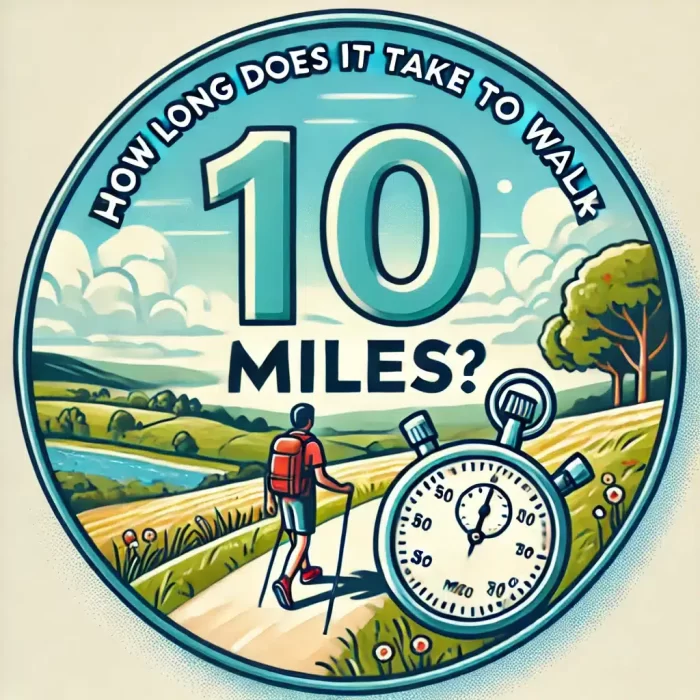How Long Does It Take To Walk 10 Miles?
How long does it take to walk 10 miles?
Well, how long is a piece of string?
Answering that question is not easy because there is no one true answer. Despite this, however, we’re going to do our best to answer it as openly as possible.
For us to look better, feel better, and be better from a health perspective, exercise is so, so important. Without sufficient amounts of exercise, not only are we more susceptible to weight gain, but we also find ourselves susceptible to all manner of illnesses and ailments.
Cardiovascular disease, for example, is the world’s biggest killer. Each year, more people die from cardiovascular disease than any other disease or health condition. Despite this, however, the condition can easily be avoided by making a series of healthy lifestyle and dietary choices.
To strengthen the heart we should do cardiovascular exercise. Walking is a fantastic form of cardio that is also great for your joints and your mental health as well. Long-distance walking in particular, can be very beneficial, which is what we’re looking at today.
How Long Does It Take To Walk 10 Miles?
Starting as we mean to go on, we’ll kick things off today by answering the main question, which is, how long does it take to walk 10 miles?
The simple truth of the matter is that there is no true answer because each person is different. Answering that question would be like answering how long to run 100 meters. Some people will manage it in under 15 seconds, some under 20, some under 30, some not at all, and a very, very select few, I.E. Usain Bolt will break World Records by running it in under 10 seconds. 9.58 seconds to be precise.
What we’re trying to get at is the fact that people of different ages, genders, shapes, sizes, and levels of fitness, will walk 10 miles at different times. If you walk at 1 mile per hour (mph) you will walk 10 miles in 10 hours. If you walk at 2mph, however, you’re walking twice as fast which means that you can cut your time in half.
This means that rather than 10 hours, you could manage it in 5 hours. To get even more technical however, if you walked at 3mph, you could walk 10 miles in 3 hours and 30 minutes. 4 miles per hour would let you achieve your 10-mile goal in just 2 hours and 30 minutes, and 5 miles per hour means you could walk 10 miles in just 2 hours.
Now, you’re probably thinking that the easiest way to walk 10 miles is to get it over with quickly and that walking at 5mph is the way to go. In theory, that would be correct, but 5 miles per hour is a very quick speed to walk at, in fact, some people would struggle to run at that speed, and they certainly wouldn’t be able to maintain that speed for 10 miles.
As mentioned, different people will walk at different speeds, it could take you 10 hours, it could take you 5 hours, or if you were very quick, very fit, and were walking in perfect conditions, it could take you 2 hours, or even less time than that.
Different Factors That Will Affect Walking Speed And Time
To help you get a better understanding of just how long it will take to walk 10 miles, here’s a look at several different factors that will affect your walking speed and the time it takes to reach your objective.
Your Walking Speed
One of the most important factors to consider is your walking speed.
If you want to walk at a leisurely pace and enjoy your surroundings, you can go ahead and slow things down so that you get time to take in the views.
If for example, you’re out hiking in the wilderness, amongst some of the most spectacular views you could ever wish for, if you slowed things down and walked at a leisurely 2 miles per hour, you could achieve your 10-mile goal in 5 hours. If you wish to walk faster, however, you’ll achieve your 10-mile goal much quicker.
Whenever you are walking or hiking, however, it’s important to ensure that you only walk at a speed that you are comfortable with. Don’t try walking faster than usual if you’re going to be out of breath, dealing with aching joints, or suffering with blisters for example. As long as you’re comfortable, that’s all that’s important.
The Weather Conditions
If you’re walking 10 miles indoors, on a treadmill perhaps, then the weather conditions outdoors won’t affect you. If, like most long-distance walkers or hikers, however, you choose to do your walking or hiking outdoors, the weather can be very important indeed.
Before you embark on any walk, hike, jog, run, or cycle, make sure you check the weather forecast beforehand. The weather can have a huge influence on how fast you’re able to walk, and it can also be dangerous. If for example, you’re out hiking high up in the trails of a mountain, optimal conditions will be fairly mild, nice, and dry, with a very gentle breeze to help keep you cool.
Walking in these conditions shouldn’t slow you down in the slightest. However, if you’re out hiking in the rain, with driving winds in your face, not only will the wind slow you down, but you’ll need to walk slower as visibility will be so poor.
Not only that but if it is raining, the ground will be slippery and may be muddy, which will also slow you down considerably. Put very simply, if the weather is bad, you can expect the 10-mile goal to take much longer than if you were walking in perfect conditions.
The Walking Terrain
Another hugely important consideration when it comes to walking 10 miles, and indeed, how long it will take you, is the terrain on which you walk.
Make no mistake about it, the terrain that you walk on will have a huge impact on not only how long it will take you to complete your 10-mile walk, but also on your levels of comfort, and even your safety.
If you’re walking on flat, fairly grippy terrain that isn’t too hard underfoot, you will complete a 10-mile walk much faster than you would on harder terrain to navigate.
Hiking through thick foliage, mud, sand, slippery rocks, or uneven surfaces for example, will take much longer so you should allow extra time for your hike. To make matters worse, if you encounter bad weather, previously smooth and firm terrain could become muddy or boggy if it rains, which means that your journey will take much longer.
When walking on hazardous terrain, not only will you need to ensure that you are hiking at a decent pace, but you also need to ensure that you are walking safely. If you walk on slippery or uneven terrain, you run the risk of slipping over, spraining your ankle or knee, breaking a bone, or worse. If you are walking 10 miles and some of the journey is on uneven, rough, or slippery terrain, just be aware that your journey will take a lot longer.
Alone Or With Company?
If you are walking alone for example, you’ll have fewer distractions and will be more likely to simply focus on the walk and on getting from A to B as quickly and as easily as possible. With company, either with a friend or as part of a walking group, for example, your journey is likely to take longer because there are other factors to consider.
For example, if you are walking with somebody else, you’ll likely stop more to chat, or to point things out on the hike perhaps. Not only that but when walking with other people, you’re only as fast as the slowest member of your group.
If you have somebody who is naturally slower than you, you’ll need to slow the pace down to allow them to catch up, as you certainly can’t leave them behind. As far as how long to walk 10 miles is concerned, you’re far more likely to complete those 10 miles much faster if you’re walking alone, rather than with company.
The Urgency Of The Walk
Another very important consideration when determining the duration of any walk or hike, regardless of the distance, is the urgency.
If you have to be home at a specific time for example, or if you have made plans later on in the day, you will likely walk at a much faster pace than if not. On the other hand, if you have nothing planned, and nothing to do, other than enjoy your surroundings and the views as you walk, you may wish to slow things down and walk at a slower pace.
As you can see, walking just 1 mile per hour faster can potentially cut the duration of a 10-mile walk in half, so if you do need to be home at a certain time, walking faster will help ensure that you aren’t late.
Your Physical Fitness
Finally, the last factor when it comes to determining how long to walk 10 miles is your overall levels of physical fitness.
Needless to say, the fitter you are, the greater your stamina is, and indeed, your ability to maintain a quick walking speed, the faster you will be able to complete a 10-mile walk. People who exercise regularly, are a healthy weight, watch what they eat, and regularly perform plenty of aerobic exercise will likely be fitter than those who don’t do those things.
This means that they will be able to complete a 10-mile walk much quicker.
If you are looking for ways of walking faster and completing a 10-mile walk quicker in the process, plenty of cardio, many squats a day, aerobic exercise, water, and healthy foods will do wonders.
The fitter and healthier you are, the faster you’ll be able to walk and the better your stamina and endurance will be, meaning that you complete those 10 miles quicker.
Long Distance Walking Tips

Okay, so, assuming that you’ve got a 10-mile hike in the pipeline, or perhaps you’ve already hiked 10 miles but are unhappy with how long it took you, you’ll no doubt be looking for ways of becoming a more efficient walker. This is where we enter the fold. Here are several long-distance walking tips to help you become a better long-distance walker.
Wear The Right Kit
First and foremost, if you are looking for ways of walking 10 miles much quicker than you are perhaps used to, it’s important to wear the right kit.
Far too many people out there who are looking to walk long distances will make the mistake of wearing the wrong kit and bringing along the wrong equipment, and they will then wonder why it feels harder and takes them longer than it should. When you’re walking, make sure you invest in a good quality pair of walking/hiking boots. The clue is in the name, so never try to save a few bucks by going with generic running shoes.
Running shoes are for running, and walking shoes or boots are for walking. Not only should you wear the correct footwear, but you should also make sure that you wear the right clothing.
If you wear clothing that is too tight, too restrictive, or simply too uncomfortable, your performance will be affected, as will your overall levels of comfort. If you’re uncomfortable you won’t be able to focus on the walking as you’ll be too concerned with your clothing.
Gradually Work Your Way Up To 10 Miles
If you’re new to walking long distances, obviously 10 miles will not be achievable right away. The key is to start slowly and work your way up to 10 miles.
Based upon your levels of fitness and your endurance, start off with short walks of around 2 miles or so, time yourself, and gradually increase the distance each time you head out on a hike.
For the first week, you could stick with 2-mile hikes, increase this to 2.5 miles the following week, 3 miles the next week, and so on. Once you reach 10 miles, then you can start worrying about it!
Have A Training Program Created
Walking 10 miles is no small feat, and if you’ve never covered those kinds of distances beforehand, it’s important to do things correctly. You can’t suddenly decide to walk 10 miles one day with no prior experience or any gauge of your speed or fitness levels. This is where it pays to hire a professional such as a personal trainer or coach, and have them create a training program for you.
By following a training program you can do things the right way, minimizing your risk of injury in the process. Not only that, but you will also gradually improve your fitness and stamina as you will be learning from a professional.
Always Stretch And Warm Up First
Before you engage in any physical activity, you should always take the time to stretch and warm up.
People assume that just because they’re walking, they don’t need to stretch their muscles or warm up because walking is a low-intensity, low-impact form of exercise. The truth is that you could easily pull a muscle or tear a muscle when walking, especially if you are covering long distances.
If you stretch and warm up before you begin your hike, you will also likely walk faster and more efficiently, meaning you’ll cover those 10 miles quicker anyway.
Frequently Asked Questions:
How many steps are in a 10-mile walk?
On average, a person takes around 20,000 to 25,000 steps to complete a 10-mile walk, depending on their stride length.
Can I walk 10 miles every day?
Yes, but it depends on your fitness level. Walking 10 miles daily is an intense workout and can be beneficial for cardiovascular health and weight loss, but proper recovery and footwear are essential to prevent injuries.
How many calories do you burn walking 10 miles?
The number of calories burned depends on weight and walking speed. A person weighing 150 lbs burns about 700–1,000 calories, while someone heavier may burn more.
How long does it take to walk 10 miles on a treadmill?
Walking on a treadmill at 3 mph takes around 3 hours and 20 minutes, while at 4 mph, it takes 2 hours and 30 minutes. Incline settings can impact the effort and time required.
Is walking 10 miles good for weight loss?
Yes! Walking 10 miles can significantly contribute to weight loss if combined with a healthy diet. The key is consistency and maintaining a calorie deficit.
Is walking 10 miles harder than running 10 miles?
Walking takes longer and requires endurance, but running is more intense and burns more calories in less time. Walking is lower impact and better for those with joint issues.
Final Thoughts:
With that, our look at how long does it take to walk 10 miles comes to an end. Hopefully, the info contained above has been useful, informative, insightful, and easy to understand. Walking long distances not only helps burn calories, tone muscles, and build your fitness, but it can also improve your mental health too.
By following the info above, you will soon be walking 10 miles faster than ever before and ready to take on your next outdoor adventure!






